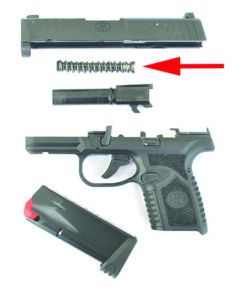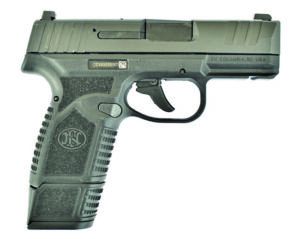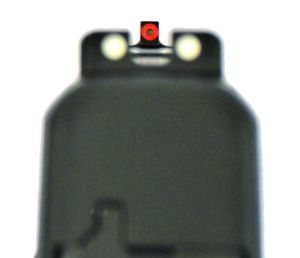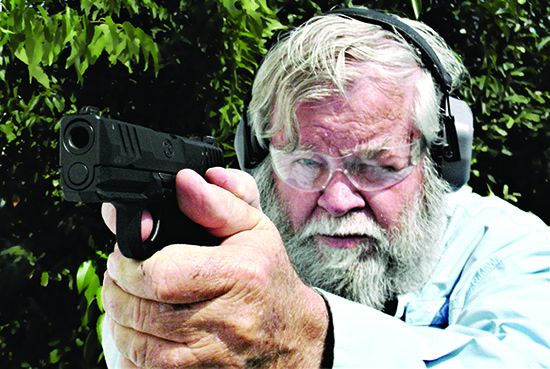Among the trends we have noted over the past decade is the replacement of the snubnose 38 Special revolver with the slim-line 9mm Luger pistol. Pistols such as the 9mm Smith & Wesson Shield and Glock 43 are the most popular pistols for concealed carry these days, but SIG took the platform even further with the SIG P365, a 10-shot 9mm with good reliability and practical accuracy. Other makers followed suit, including Smith & Wesson with the Shield Plus and Ruger with the Max 9. In this installment, we match up three comparable handguns, but each with different features. These makers have managed to stuff as many as 17 rounds into the magazine. Two offer a flush-fit magazine for pocket carry and an extended magazine for holster carry.
The FN Reflex is a different type of polymer-frame subcompact. It is a hammer-fired pistol with a concealed hammer. While similar in appearance to the archetypal 9mm striker-fired handgun, this is a different action type. The Reflex is a slim, compact pistol with good features and is both the smallest and the least expensive handgun tested here.

The Shadow Systems CR920 Combat Sub-Compact is more similar to the Glock 43 9mm than a Glock 26 9mm pistol in our opinion. The pistol is a high capacity version of slim-line handguns. Two magazines are supplied, one 10 round flush fit and one extended 13-round magazine. The pistol is short on ammunition capacity compared to the FN, but on the other hand, it is more compact as well. The pistol is only 1.05 inch wide.
The SIG Sauer P365 XMacro Tacops 365XCA-9-Tacops is very similar to the original XMacro in appearance. However it features a solid slide without compensator and a 3.7-inch barrel as well as forward and rear cocking serrations, X-Ray3 sights, and a well-designed grip frame with an excellent stippling treatment. The new light rail is longer than the original P365 and is more versatile in mounting lights.
Here’s what we thought of them in more detail.
FN America FN Reflex 66-1014089mm Luger
$499
GUN TESTS GRADE: A (BEST BUY)
After the smoke had cleared, the Reflex 9mm had exhibited no misfires, failures to feed, or failures to fire. Recoil is modest for the pistol’s size. Cocking serrations and grip treatment are well done. This is a well-designed pistol.

| Action Type | Semi-auto, single action, internal hammer fired; short-recoil-operated lock breech |
| Overall Length | 6.0 in. |
| Overall Height w/flush-fit magazine | 4.5 in. |
| Overall Height w/extended magazine | 5.0 in. |
| Maximum Width | 1.0 in. |
| Weight Unloaded | 18.4 oz. |
| Weight Loaded | 23.6 oz. |
| Slide | Steel, black PVD finish, front and rear slide cuts, rail |
| Slide Retraction Effort | 15.0 lbs. |
| Receiver Material | Black polymer |
| Front Strap Height | 2.1 in. |
| Rear Strap Height | 2.8 in. |
| Barrel | 3.3 in. long; 1:10 RH twist |
| Grip Thickness Maximum | 1.0 in. |
| Grip Circumference | 5.2 in. |
| Magazines | 11- and 15-round |
| Rear Sight | Post rear |
| Front Sight | Tritium single dot |
| Sight Radius | 5.0 in. |
| Trigger Pull Weight | 4.5 lbs. |
| Trigger Span | 2.5 in. |
| Safety | No manual safety |
| Warranty | 5 years |
| Telephone | (703) 288-3500 |
| Website | FNAmerica.com |
| Made In | USA |
We want to acknowledge southpaws early in this particular installment by noting that the Reflex and the other pistols are equal in every regard when fired left-handed. A left-handed shooter will have no problem using any of these handguns well.
Elsewhere, we cannot recall seeing such an even spread in price as we did with the FN handgun. The Reflex was listed at $499 at every outlet we checked. It ran well and never failed to function. There were no shooter-induced malfunctions as we found with the Shadow.
This is a subcompact pistol with a slide barely an inch thick. The slide is well machined and finished. FN took the time to design different types of cocking serrations with the front angled differently than the rear. The front of the slide is scalloped to allow easy holstering. The area around the barrel hood on the left side of the pistol is nicely indented. A loaded-chamber indicator is simply a witness hole in the barrel hood. The pistol features a robust extractor.
The frame features a light rail for mounting lights and lasers. The grip frame features a well thought out mixture of stippling, pebbling, and serrations. The slide lock is easily manipulated, but not likely to be activated when firing during recoil. We had a problem with the Shadow Systems CR920 in this regard that was resolved by the staff, but was still unwelcome. The magazine release is nicely protected and easily activated. While the controls are set up for right-hand use, the magazine release is reversible.

This brings us to the trigger. A single-action trigger, the Reflex’s trigger action is advertised at 5.0 pounds. Ours actually broke at a very clean 4.6 pounds. It is a good-feeling trigger with little take-up. Reset is rapid and audible.
The pistol is supplied with a flush-fit 11-round and an extended 15-round magazine. The 11-round magazine features a slight finger rest. A supplied flat magazine base may also be installed. Each locks in securely. The magazines are not difficult to load to capacity.
We moved to the firing tests with two types of 9mm Luger FMJ ammunition. We used Federal Syntech 124-grain and Fiocchi 115-grain rounds. During the firing tests, all commented on the pistol’s clean trigger break. The sights are good for close-range combat-style shooting. The front sight is easily picked up. However, the tritium dot is small and not as bright as the other two handguns.
The trigger made for excellent accuracy. The grip is also well designed. The raters noted the size of the FN’s handle was ideal compared to the blockish Shadow Systems grip. The pistol homed in on targets and gave good results. It was not as controllable as the bigger SIG Tacops, but the Reflex did well for its size.
Off the bench, the FN Reflex was slightly more accurate in slow fire than the Shadow Systems, almost splitting hairs but measurable. We used three loads in this contest to measure bench accuracy: Remington 115-grain High Terminal Performance (HTP) jacketed hollow points, Black Hills Ammunition Factory New 124-grain JHP +P cartridges, and Federal Premium 124-grain HST hollow points. We fired at 15 yards in deference to the pistols’ shorter sight radii. The FN Reflex registered one 2-inch five-shot group, although most of the groups were larger.
There were no failures to feed, chamber, fire, or eject with the Reflex. The pistol did well with either magazine, and we felt the 11-rounder offered an adequate grip. The sights are a dovetail front with luminescent orange surrounding a tritium insert. The sights are good but not as bright as the other pistols in dim light, but just as visible in normal light.
The trigger action was the subject of some debate. While it is a two-piece trigger, there is no trigger lever — same as the SIG — and the pistol has no manual safety. In effect, you are carrying cocked and locked without a safety — actually, make that cocked and unlocked. The two-piece trigger and firing-pin block are basically a drop safety. We would never carry this pistol in a pocket without a holster (but we also would not carry a handgun without a holster at all) to avoid snagging the trigger with something in the pocket. Of course, all handguns should be properly holstered.
FN claims that the Reflex is easy to rack compared to a striker-fired pistol. We fail to see how this could be accurate. A Glock-type striker-fired pistol is partially cocked when racked, and the trigger finishes moving the striker to the rear, breaking it against the sear and firing the pistol. A hammer actually demands more force to rack. Anyway, the FN was definitely in the middle of racking effort. But then none of the tested pistols were difficult to rack and make ready.
Our Team Said: In all, we found the FN Reflex to be a nicely handling pistol. Accuracy and reliability are proven in our tests. The Reflex is a great shooter, far ahead of the Glock 26 or FN 503 of a few years ago. The deficit in accuracy is primary at longer range. The FN Reflex is a Best Buy due to its price, reliability, good sights, and capacity.
| 9MM LUGER RANGE DATA | |||
| Remington HTP 115-grain JHP | SIG Sauer P365 XMacro Tacops | Shadow Systems CR920 Sub-Compact | FN America FN Reflex |
| Average Velocity | 1160 fps | 1144 fps | 1150 fps |
| Muzzle Energy | 344 ft.-lbs. | 334 ft.-lbs. | 338 ft.-lbs. |
| Small Group | 1.1 in. | 1.5 in. | 1.4 in. |
| Average Group | 1.5 in. | 2.0 in. | 2.0 in. |
| Federal Premium 124-grain HST JHP | SIG Sauer P365 XMacro Tacops | Shadow Systems CR920 Sub-Compact | FN America FN Reflex |
| Average Velocity | 1139 fps | 1120 fps | 1107 fps |
| Muzzle Energy | 357 ft.-lbs. | 345 ft.-lbs. | 337 ft.-lbs. |
| Small Group | 0.9 in. | 1.3 in. | 1.1 in. |
| Average Group | 1.4 in. | 1.6 in. | 1.5 in. |
| Black Hills Factory New 124-grain JHP +P | SIG Sauer P365 XMacro Tacops | Shadow Systems CR920 Sub-Compact | FN America FN Reflex |
| Average Velocity | 1183 fps | 1140 fps | 1160 fps |
| Muzzle Energy | 385 ft.-lbs. | 358 ft.-lbs. | 370 ft.-lbs. |
| Small Group | 1.0 in. | 1.3 in. | 1.3 in. |
| Average Group | 1.5 in | 1.8 in. | 1.7 in. |
We fired groups at 15 yards from a benchrest position using an MTM Case-Gard K-Zone Shooting Rest. We used a Competition Electronics Pro Chrony to measure muzzle velocities.
Written and photographed by Gun Tests Staff, using evaluations from Gun Tests Team members. GT

























